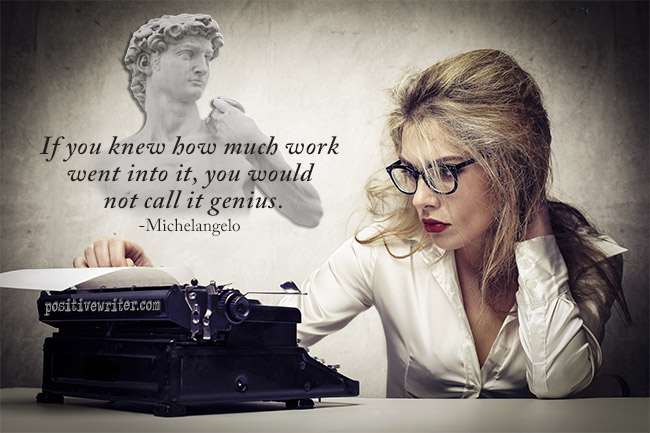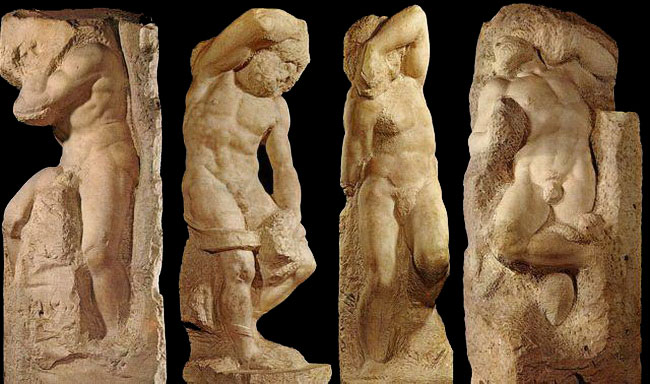When there’s a giant obstacle blocking me from my desk chair, it’s always the same question: Why did I think I could be a writer?

It’s worse than writer’s block, a missing muse, or even the inner critic – because sometimes I don’t even make it far enough for those other hurdles to step in.
This is Writer’s Doubt: self-sabotage and fear that burrows so deep inside of me, so thoroughly, that I don’t know what’s real and what’s not.
But there’s one thing I do know that’s real, and it’s a moment that I turn to again and again– the moment I saw Michelangelo’s sculptures in Florence, The Unfinished Slaves.
I saw the angel in the marble and I carved until I set him free. ~Michelangelo

You see, I had traveled to Italy to take it all in– the art, the cafés, the charm– and I expected this to magically fuel beautiful writing.
When it wasn’t that easy, I just felt very, very lonely.
And loneliness breeds doubt.
I questioned why I was standing in line to see Michelangelo’s David instead of working on my story.
After all, by the time I made it to the Gallery Accademia, I had already seen David’s body on souvenir barbecue aprons, his [ahem] on novelty condom wrappers, not to mention the actual full-size replica in the piazza.
But, I had to see the David just so I could say so.
And like I said, I was lonely. It felt good to go through the motions of the experience I thought I should be having.
After an hour in line, I came to terms with what a phony I was because I just. didn’t. care.
And then, before I made it to the David, I saw the most beautiful artwork I’ve ever had the honor of standing in front of. There was no crowd or line waiting to see these massive hunks of unpolished stone:
The Prisoners, The Slaves, The Unfinished Ones.

I gazed up at the prisoners in the marble: Larger-than-life men, half-fighting their stone cages, half-content to die there.
Michelangelo knew how to dig them out. All he had to do was hammer in the right places– just like all we writers have to do is put one word after another.
These sculptures pierced through my loneliness and self-doubt, and I was left with a whisper stuck in my lungs– I was overwhelmed with the contrast of these crude blocks and the angels he found inside of them.
All Michelangelo had to do was clear away the muck. With each clink clink clink of his chisel, he cleared away the to-do lists, the self-doubt, and guilt of doing what he wanted.
If you knew how much work went into it, you would not call it genius. (Click to Tweet) ~Michelangelo
And the instant I accepted that Michelangelo found these creatures inside of him, which let him find their forms in the marble, I remember the work.
Michelangelo was commissioned to make 40 of these giants.
He failed.
He only began a handful of them. Chiseling marble isn’t like blowing the seeds off a dandelion, after all. It’s work.
The genius part is continuing the work, knowing somewhere inside of you that the creature is there, whether it be Atlas Slave or the hero of your novel.
Michelangelo taught me that the trick is holding on.
These sculptures are always described as non-finiti. Unfinished.
These stone gods didn’t make Michelangelo famous, but he did them anyway. They seem like an afterthought leading up the hallway to the David, but maybe they are the practice that made the David all the better.
Or maybe he left them unfinished just to catch a lonely writer off guard.
So, there I was, standing in awe– not in the beauty of a perfectly finished product, but of the work and the process.
And at that moment, the rays of these ideas converged and I felt them all: the inevitability of finding the forms, the work, and the beautiful failure.
I was moved. My planes of understanding moved, and I felt it all at once and separately at the same time. For a moment, art was faith, and understanding that concept was art in itself, too.
It was a moment that had the clarity usually reserved for falling asleep that can never be recalled– a spiritual kind of moment, even if I never knew how to describe spiritual before.
There is no doubt.
This then, is the moment that I have tucked in the folds of my mind. And still ten years after viewing these statues, I get a little teary-eyed as I remember how they looked– no– as I remember how I felt.
To feel such a strong reaction to another’s art work– You can’t feel like that and walk away.
This is the moment that I pull up when I question my decision to pursue a creative life and to call myself a writer.
When Writer’s Doubt keeps my butt from planting in the chair, this is what I reach for.
And if a brief flash of this memory can turn in to just five minutes more of overcoming Writer’s Doubt, that’s enough.
Suddenly it’s like looking at my doubt from far away, and it seems silly and obvious– just chisel it away.
So I urge you, if you’ve got that capacity to experience art (you do), to be moved in this deep way, and to feel beauty, then there is no doubt that you are on the right path. This is worth it.
Find that sentence in a book that makes you in awe of humankind, remember that film that leaves you speechless and quiet while the credits ran, or remember the sculptures, sitting ignored in a hallway in Florence, pushing you forward.
And with that moment in hand, there is no doubt.
Share your moment with us in the comments.
Congratulations, Christine! There is no doubt, you are the winner. Join me in congratulating Christine in the comments. ~Bryan
– ~-~ –
This writing contest has been extremely rewarding. With so many meaningful entries, it was anything but easy choosing the finalists. Thanks to everyone who participated, you are ALL winners over Writer’s Doubt.
PS: If you haven’t already, get your name into the “Writer’s Doubt” drawing for a $100.00 Amazon gift card. Click here for the rules and how to get your name in the hat!
